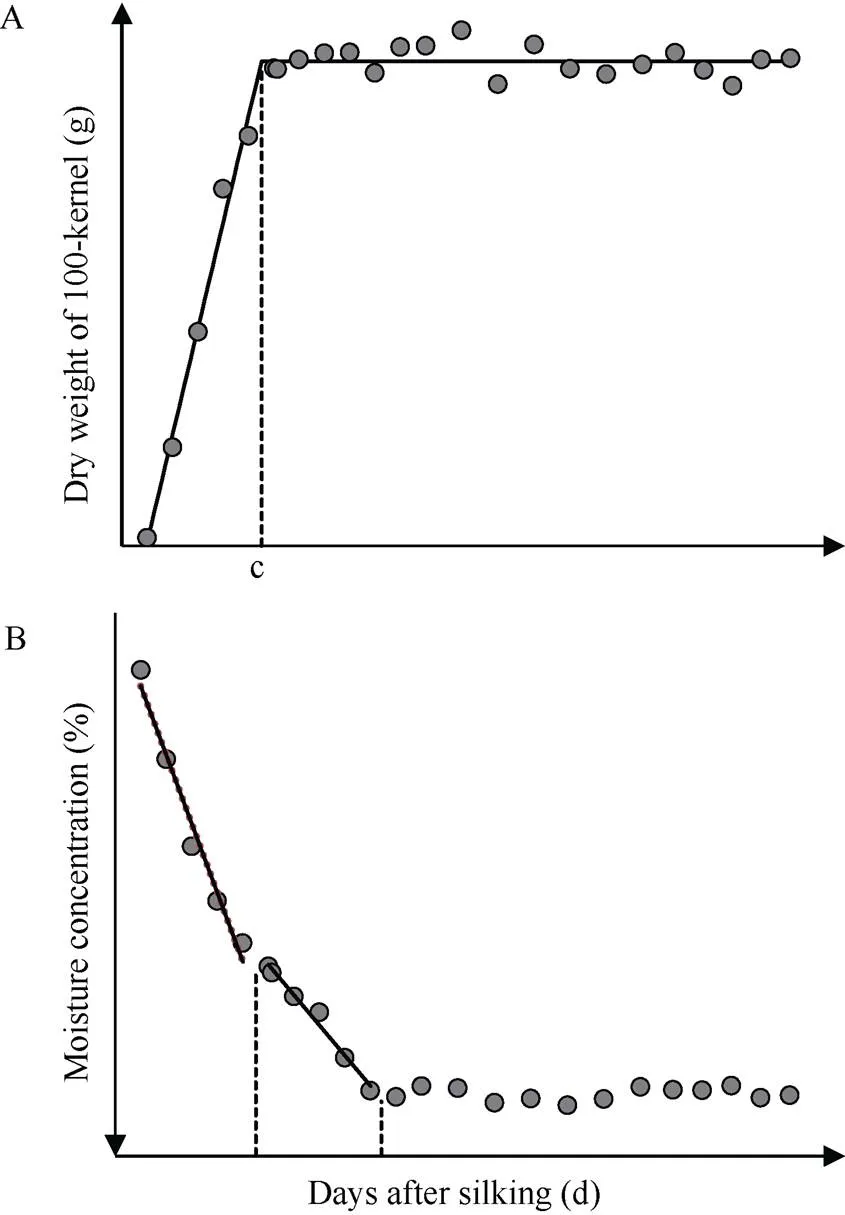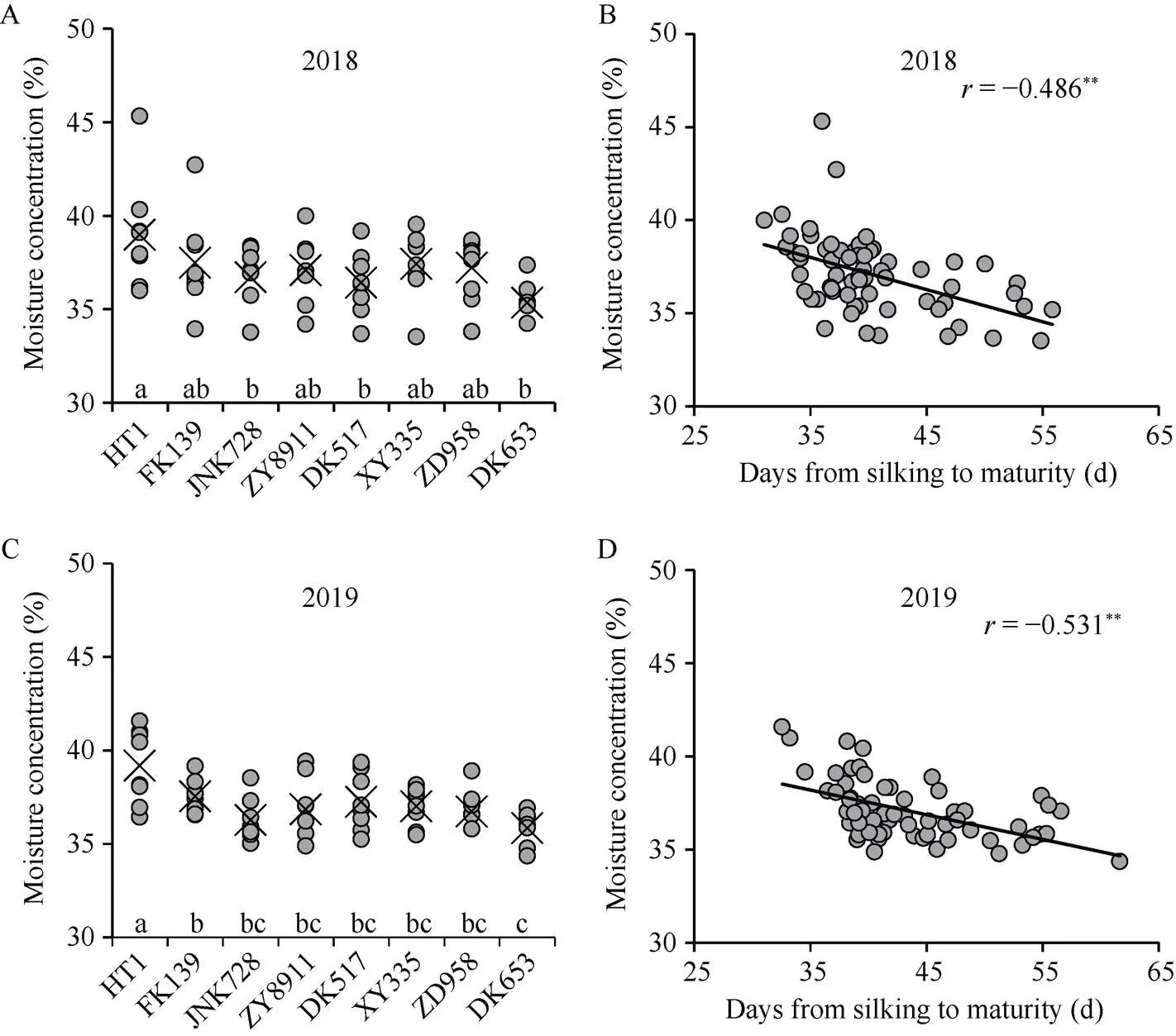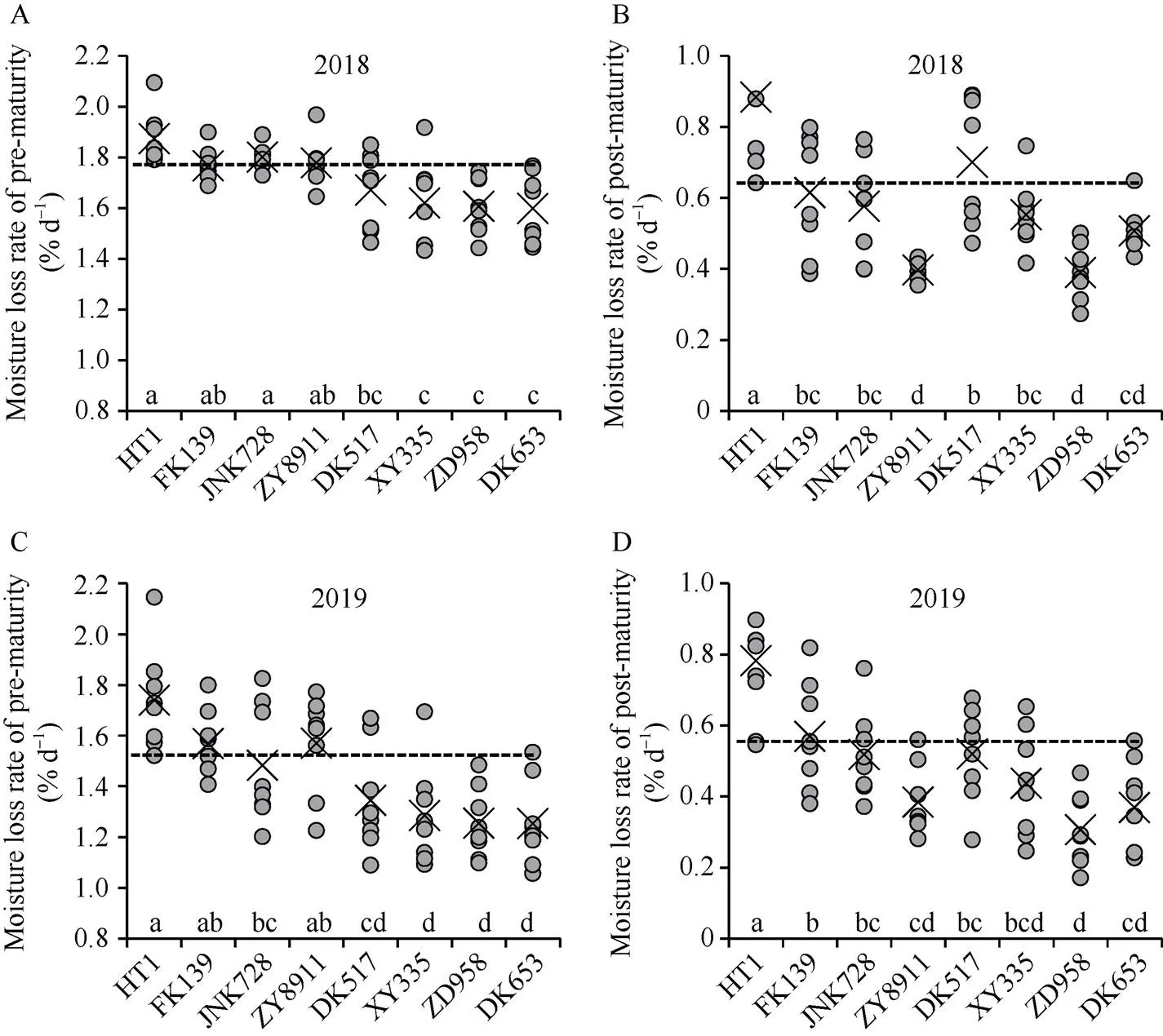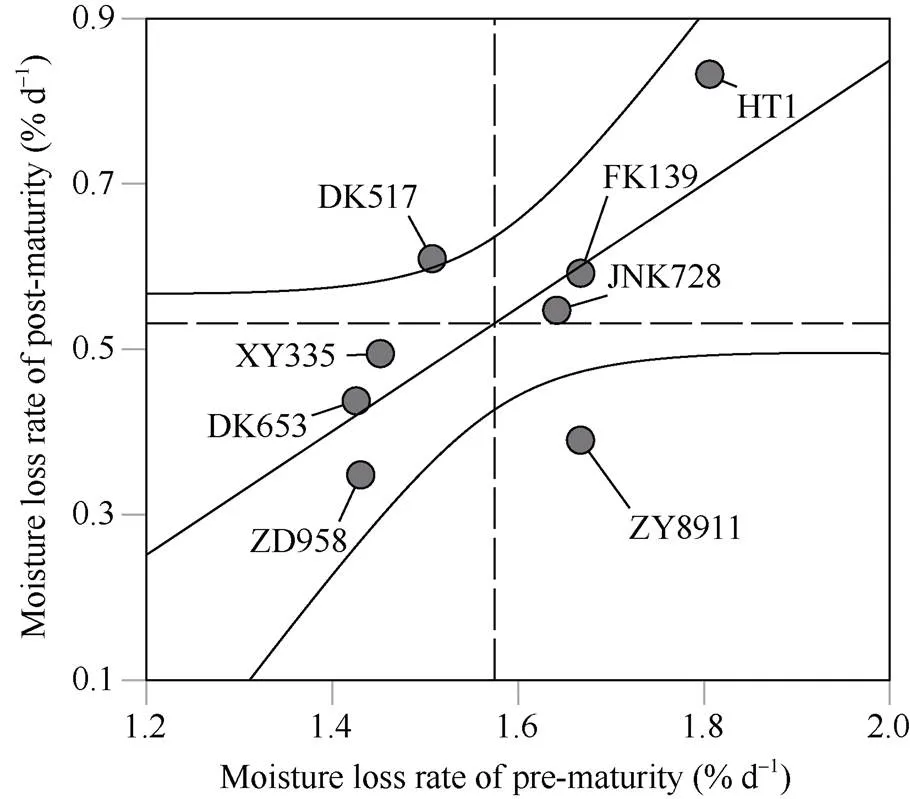不同熟期玉米品种籽粒田间脱水特征差异性分析
李璐璐 明 博 高 尚 谢瑞芝 王克如 侯 鹏 薛 军 李少昆
不同熟期玉米品种籽粒田间脱水特征差异性分析
李璐璐1,2,3明 博1,*高 尚1谢瑞芝1王克如1侯 鹏1薛 军1李少昆1,*
1中国农业科学院作物科学研究所 / 农业部作物生理生态重点实验室, 北京 100081;2海南省农业科学院三亚研究院, 海南三亚 572025;3海南省崖州湾种子实验室, 海南三亚 572025
玉米收获期籽粒含水率是影响机械粒收质量和籽粒品质的重要因素, 不同熟期品种收获期籽粒含水率有差异, 同时品种间熟期的差异也使其田间脱水的环境不同, 造成其脱水特征难以精准比较。本研究于2018—2019年, 以不同熟期玉米品种为研究对象, 设置间隔约10 d的8个播期处理, 播期覆盖自早春播至晚夏播, 创制籽粒田间脱水的环境差异, 观测籽粒含水率动态过程, 分析品种之间籽粒田间脱水特征差异。结果表明, 收获期籽粒含水率与品种生育期长短呈显著正相关(= 0.810*, 2018;= 0.912**, 2019), 早熟品种收获时含水率低、晚熟品种高; 生理成熟期籽粒含水率与灌浆期长短呈显著负相关(= –0.484**), 早熟品种生理成熟期籽粒含水率高、晚熟品种低; 籽粒生理成熟前脱水速率(= –0.655**)和生理成熟后脱水速率(= –0.492**)均与生育期长短呈显著负相关, 表现出早熟品种籽粒脱水速率快、晚熟品种脱水速率慢的特征; 籽粒生理成熟前脱水速率与生理成熟后脱水速率之间呈显著正相关(= 0.466**), 一般而言生理成熟前籽粒脱水速率较快的品种, 生理成熟后脱水速率也较快, 但是存在生理成熟前脱水速率快、生理成熟后脱水速率慢的特例品种。本研究认为生育期影响籽粒脱水速率, 通常早熟品种生理成熟前、后籽粒脱水速率均较快, 收获期含水率较低; 晚熟品种生理成熟前、后籽粒脱水速率均较慢, 收获期含水率较高; 但是存在特例品种, 在进行籽粒快速脱水品种的选育和筛选时应引起关注。
玉米; 生育期; 籽粒; 含水率; 脱水速率
玉米收获期籽粒含水率与生理成熟前脱水速率和生理成熟后脱水速率有关, 这两个阶段脱水速率大小决定了收获期籽粒含水率高低, 以往有不少研究将关注点放在生理成熟至收获这一段时间籽粒脱水快慢与否, 即生理成熟后脱水速率[19,30-34], 弱化了生理成熟前脱水速率对收获期籽粒含水率的影响,以及生理成熟前脱水速率与生理成熟后脱水速率的关系, 同一品种生理成熟前、后脱水速率大小是否一致尚未定论。本研究选用生育期和籽粒脱水速率有较大差异的不同玉米品种, 剖析籽粒脱水速率的品种差异, 为快速脱水品种的选育和筛选提供理论指导。
1 材料与方法
1.1 试验设计
于2018年和2019年在中国农业科学院作物科学研究所新乡综合试验站(河南省新乡市, 35°18'N, 113°54'E)进行, 设置品种和播期处理。选用生育进程和脱水速率差异较大的8个品种, 包括早熟品种: 禾田1号(Hetian 1, HT1)和丰垦139 (Fengken 139, FK139); 中熟品种: 泽玉8911 (Zeyu 8911, ZY8911)、京农科728 (Jingnongke 728, JNK728)和迪卡517 (Dika 517, DK517); 晚熟品种: 先玉335 (Xianyu 335, XY335)、郑单958 (Zhengdan 958, ZD958)和迪卡653 (Dika 653, DK653)。采用早春播至晚夏播的大跨度分期播种处理, 每年8个播期(表1), 各播期之间的间隔大约为10 d。除了ZY8911在2018年的第1播期未种植外, 其他品种2年均种植8个播期。试验采用大区种植, 各处理种植面积约为158.4 m2(宽约7.2 m, 长约22 m), 等行距种植, 行距为0.6 m, 种植密度为75,000株 hm–2。播前撒施底肥, 选用控释肥(N-P2O5-K2O: 30-5-5), 每公顷约750 kg, 旋耕整地。各小区机械开沟, 人工点播, 每点位放置2粒种子, 点位之间的距离约为22 cm, 人工覆土。播种后浇蒙头水, 保证出苗, 四叶期间苗。玉米生育期内的灌水和病虫草害管理措施同当地生产, 未发生逆境胁迫。试验田安装了小型气象站(WatchDog 2900 Weather Station), 试验期间的气温、降水、风速和相对湿度情况见图1。
1.2 籽粒干重和含水率变化动态的观测
记录各处理的播种、出苗和吐丝日期。在吐丝期, 每个处理选择至少200株吐丝一致、无病虫害的代表性植株, 作为样株, 挂牌标记。取样日期从吐丝后7 d起, 持续至生理成熟后, 在12月底截止, 取样间隔大约为7 d, 如果遇到降水天气, 取样日期顺延1 d, 试验期间各处理的取样次数在17~34次之间。取样时每个处理从标记好的样株中选择5个果穗, 连带苞叶取下, 带回实验室。5个果穗分别手工脱粒, 取果穗中部的100粒测试, 分别称取鲜重, 然后在恒温鼓风干燥箱中以85℃、48 h烘干, 称量干重。根据籽粒鲜重和干重计算含水率, 5个果穗的籽粒含水率均值作为本次测试的含水率:
籽粒含水率(%)=(鲜重–干重)/鲜重×100(1)
1.3 灌浆期的计算
玉米粒重随着吐丝后天数的增加, 呈现先增长后稳定的趋势。参考GAMBÍN等[35]的方法, 用双线性模型拟合粒重的动态过程(图2-A), 拟合方程为:

图A和图B上的实线表示平均气温, 阴影表示最低气温和最高气温。
The solid lines represent the mean air temperature and the shading represents the lowest and highest air temperature on panels A and B.

表1 试验的播种日期

图2 粒重动态过程的双线性模型(A)和籽粒含水率动态过程的分阶段线性拟合(B)
式中, KW为百粒干重(g),为吐丝后天数(d),为方程在纵坐标轴上的截距,代表灌浆速率(g d–1),代表灌浆期(d),代表最大百粒干重(g)。本试验共测试127组粒重积累动态数据, 粒重与吐丝后天数双线性模型的Adjusted2在0.957~0.997之间。
1.4 生理成熟期粒含水率的计算
生理成熟日期: 灌浆的截止日期为生理成熟期, 本文用式(2)中的值判定。
生理成熟期籽粒含水率: 由于存在取样间隔, 当取样日期与生理成熟日期在同一天时, 以取样当天的实测籽粒含水率为生理成熟期籽粒含水率; 当取样日期与生理成熟日期不在同一天时, 将生理成熟期前一次和后一次取样时的实测含水率数据线性插值, 以此获取生理成熟期籽粒含水率。
1.5 籽粒生理成熟前、后脱水速率的计算
玉米籽粒含水率随着吐丝后天数的增加, 呈现出单调递减的趋势, 直到降至稳定。籽粒含水率的动态过程可以划分为3个阶段: 吐丝至生理成熟(生理成熟前)、生理成熟至含水率最低(生理成熟后)和含水率稳定在最低水平。对籽粒含水率生理成熟前、后的下降过程分别进行线性拟合, 以线性方程斜率的绝对值作为生理成熟前、后的脱水速率(图2-B)。此处, 各组观测数据生理成熟前、后的分段点以式(2)中的值为参考; 生理成熟后的截止点以籽粒含水率降至最低值, 且此后维持稳定的日期为参考, 该日期的判定以各组含水率动态数据多重比较结果为准。本试验共测试127组籽粒含水率动态数据, 含水率与吐丝后天数分段线性拟合的Adjusted2生理成熟前在0.931~0.998之间, 生理成熟后在0.838~ 0.996之间。
1.6 数据处理
粒重动态变化的双线性模型拟合、多重比较、简单相关分析、偏相关分析等通过IBM SPSS Statistics 26.0完成; 籽粒含水率动态数据的分段线性拟合和线性插值在Microsoft Excel 2013中进行; 图形绘制在IBM SPSS Statistics 26.0和Microsoft Excel 2013中完成。多重比较采用Duncan的SSR检验法; 相关分析采用Pearson相关系数, 双尾检验。
响应政府规划,紧随行业发展趋势,投入智慧商圈建设,通过大数据处理分析,根据智慧停车、停车诱导的项目经验,得到集商圈管理、分析决策和用户服务于一体的综合产品、一站式解决方案,推动传统商业模式向基于大数据的精准化营销转型。
2 结果与分析
2.1 不同熟期玉米品种收获期籽粒含水率差异
参试的玉米品种生育进程存在较大差异。以第5播期(大田生产常规播期)为例, 出苗至成熟的天数, 2018年(图3-A)早熟品种(HT1和FK139)为76~ 77 d, 中熟品种(JNK728、ZY8911和DK517)为79~ 84 d, 晚熟品种(XY335、ZD958和DK653)为87~89 d;2019年(图3-D)早熟、中熟和晚熟品种分别为81~ 82 d、87~89 d和97~104 d。
不同熟期玉米品种在收获期的籽粒含水率存在较大差别, 熟期短的品种收获期籽粒含水率相对较低, 熟期长的品种相对较高。在10月1日当天, 第5播期的8个品种籽粒含水率2018年在12.34%~ 23.41%之间(图3-B), 2019年在11.55%~29.00%之间(图3-E), 含水率与生育期长短显著正相关(图3-C, F)。

图3 不同玉米品种在第5播期的生育进程(左)、10月1日籽粒含水率(中)以及含水率与生育期的相关性(右)
*和**分别表示在0.05和0.01概率水平差异显著。禾田1号(Hetian 1, HT1)、丰垦139 (Fengken 139, FK139)、泽玉8911 (Zeyu 8911, ZY8911)、京农科728 (Jingnongke 728, JNK728)、迪卡517 (Dika 517, DK517)、先玉335 (Xianyu 335, XY335)、郑单958 (Zhengdan 958, ZD958)、迪卡653 (Dika 653, DK653)。
*and**indicate significant differences at the 0.05 and 0.01 probability levels, respectively. HT1: Hetian 1; FK139: Fengken 139; ZY8911: Zeyu 8911; JNK728: Jingnongke 728; DK517: Dika 517; XY335: Xianyu 335; ZD958: Zhengdan 958; DK653: Dika 653.
2.2 不同熟期玉米品种生理成熟期籽粒含水率差异
生理成熟期籽粒含水率在不同熟期品种之间具有显著差异(图4-A, C), 表现出越早熟品种生理成熟期含水率越高的特征; 生理成熟期籽粒含水率与灌浆期长短呈极显著负相关(图4-B, D)。
2.3 不同熟期玉米品种籽粒脱水速率差异
不同玉米品种之间生理成熟前、后的籽粒脱水速率均具有显著差异。8个品种生理成熟前籽粒平均脱水速率, 2018年在1.60%~1.87% d–1之间(图5-A), 2019年在1.25%~1.74% d–1之间(图5-C), 随着品种生育期延长, 生理成熟前籽粒脱水速率降低, 二者呈极显著负相关关系(= –0.655**, 表2)。8个品种生理成熟后籽粒平均脱水速率, 2018年在0.39%~ 0.88% d–1之间(图5-B), 2019年在0.31%~0.78% d–1之间(图5-D), 随着生育期延长, 生理成熟后籽粒脱水速率也呈降低趋势, 二者极显著负相关(= –0.492**, 表2)。
在早春播至晚夏播的环境影响下, 同一品种籽粒脱水速率在不同播期之间具有较大变动, 但是所有播期下HT1的生理成熟前籽粒脱水速率基本上均大于ZD958和DK653, 所有播期下HT1的生理成熟后籽粒脱水速率基本上均大于ZD958、DK653和ZY8911。
生理成熟前脱水速率与生理成熟后脱水速率之间表现为极显著正相关关系, 简单相关系数= 0.466**, 偏相关系数= 0.218*(生理成熟前、后脱水速率均与生育期显著相关, 剔除生育期影响), 即生理成熟前籽粒脱水速率较快的品种, 生理成熟后脱水速率也较快, 但是品种ZY8911为特例, 属于生理成熟前籽粒脱水速率较快, 而生理成熟后籽粒脱水速率较慢的品种(图6)。

图4 生理成熟期籽粒含水率及其与灌浆期的关系
图中小写字母表示在0.05概率水平差异显著,**表示在0.01概率水平差异显著, × 为样本均值, 缩略词同图3。
Different lowercase letters indicate significant differences at the 0.05 probability level.**indicate significant differences at the 0.01 probability level. × represents the sample mean. Abbreviations are the same as those given in Fig. 3.

图5 不同玉米品种生理成熟前、后籽粒脱水速率
图中小写字母表示在0.05概率水平差异显著, ×为样本均值, 虚线为HT1样本值的下端线, 缩略词同图3。
Different lowercase letters indicate significant differences at the 0.05 probability level. × represents the sample mean, and the dotted lines indicate the lower sample borders of cultivar HT1. Abbreviations are the same as those given in Fig. 3.

表2 脱水速率与生育期的相关分析
*和**分别表示在0.05和0.01概率水平差异显著。
*and**represent significance at the 0.05 and 0.01 probability levels, respectively.

图6 生理成熟前、后籽粒平均脱水速率的关系
实线为线性拟合方程及95%置信区间, 垂直虚线为生理成熟前脱水速率的平均值, 水平虚线为生理成熟后脱水速率的平均值, 缩略词同图3。
The solid lines are the linear fitting equation and the 95% confidence interval, the vertical dotted line is the average of the moisture loss rate before physiological maturity, and the horizontal dotted line is the average of the moisture loss after physiological maturity. Abbreviations are the same as those given in Fig. 3.
3 讨论
当前, 中国玉米产业正在以机械籽粒收获为突破, 建立适应规模化生产的栽培技术体系, 实现由传统生产向现代化方式的转变。玉米收获期籽粒含水率影响着机械粒收质量、籽粒品质、收获后的管理技术以及烘干成本等, 筛选和选育籽粒脱水快的品种成为当前玉米产业发展和遗传育种研究的热点问题。
在相同的生产条件下, 早熟品种收获期籽粒含水率低而晚熟品种含水率高, 这可能与早熟品种生育进程相对较短、籽粒田间干燥过程处于相对更高的温度条件有关。品种间生长发育进程的差异使籽粒处于不同的气象环境条件之下, 难以准确评价品种的脱水特征。本研究利用播期处理, 自早春播至晚夏播, 创造了籽粒干燥脱水的不同气象环境。研究发现, 所有播期下早熟品种HT1的籽粒脱水速率基本上均大于晚熟品种ZD958和DK653, 即使HT1籽粒在晚夏播的相对低温条件下, 脱水速率依然快于在早春播高温条件的ZD958和DK653。分析表明, 生育期与籽粒脱水速率呈显著负相关, 生育期短的品种生理成熟前、后籽粒脱水速率均较快, 收获期籽粒含水率较低。基因型特别是熟期性状的差异是决定品种籽粒脱水速率的重要因素。以往在以产量为首要目标的生产管理下, 延长品种生育期成为增产的有效途径, 忽视了籽粒脱水过程, 造成我国玉米收获期籽粒含水率较高的现状[36]。然而, 在机械粒收技术模式下, 收获期籽粒含水率过高不仅影响收获质量, 还会造成收获后籽粒存储困难、增加烘干成本, 处理不当还会引起籽粒霉变率升高、籽粒品质下降。因此, 机械粒收技术条件下的栽培模式构建, 应选择适宜熟期的品种, 依据种植区气候条件分配籽粒成熟和脱水的时间, 使其能够在合理的收获期内达到适宜机械粒收的籽粒含水率水平。
收获期籽粒含水率与生理成熟前脱水速率和生理成熟后脱水速率有关, 不同基因型之间生理成熟前、后籽粒脱水速率均有显著差异[15-21], 本文的研究结果与此一致。以往研究更关注不同品种在生理成熟至收获这一时期内籽粒脱水速率的快慢[19,30-34], 忽视了生理成熟前与生理成熟后两个阶段内籽粒脱水速率的联系。本研究发现, 籽粒生理成熟前脱水速率与生理成熟后脱水速率之间具有正相关关系, 即生理成熟前脱水快的品种生理成熟后脱水也快。但中熟品种ZY8911的表现与其他品种差异明显, 其生理成熟前脱水速率相对较快而生理成熟后脱水速率较其他品种慢。ZY8911的苞叶包裹紧实、果穗较粗; 前人研究认为, 苞叶长短和层数[37]、果穗粗细和长度[38-39]、粒型和组分[31,33-34]等穗部性状[30,40-49]对籽粒脱水都会产生影响, 这可能与ZY8911生理成熟后脱水速率慢有关。因此, 在机械粒收品种筛选和选育过程中, 应关注品种的熟期和脱水特征, 依据不同生态区的热量资源, 选择熟期适宜的品种, 并兼顾生理成熟前和生理成熟后籽粒脱水速率, 在保障产量的前提下降低玉米收获期籽粒含水率。
4 结论
不同熟期玉米品种之间, 收获期籽粒含水率、生理成熟期籽粒含水率、籽粒生理成熟前脱水速率和生理成熟后脱水速率均具有显著差异。生育期与籽粒脱水速率呈显著负相关, 早熟品种生理成熟前、后籽粒脱水速率均较快, 收获期含水率较低; 晚熟品种生理成熟前、后籽粒脱水速率均较慢, 收获期含水率较高。籽粒生理成熟前脱水速率与生理成熟后脱水速率之间显著正相关, 即生理成熟前籽粒脱水速率较快的品种, 生理成熟后脱水速率也较快, 但是存在特例品种, 在进行籽粒快速脱水品种的选育和筛选时应引起关注。
[1] Borrás L, Gambín B L. Trait dissection of maize kernel weight: towards integrating hierarchical scales using a plant growth approach., 2010, 118: 1–12.
[2] Brooking I R. Maize ear moisture during grain-filling, and its relation to physiological maturity and grain-drying., 1990, 23: 55–68.
[3] Gambín B L, Borrás L, Otegui M E. Kernel water relations and duration of grain filling in maize temperate hybrids., 2007, 101: 1–9.
[4] Sala R G, Andrade F H, Westgate M E. Maize kernel moisture at physiological maturity as affected by the source-sink relationship during grain filling., 2007, 47: 711–716.
[5] Sala R G, Westgate M E, Andrade F H. Source/sink ratio and the relationship between maximum water content, maximum volume, and final dry weight of maize kernels., 2007, 101: 19–25.
[6] 李璐璐, 明博, 高尚, 谢瑞芝, 侯鹏, 王克如, 李少昆. 夏玉米籽粒脱水特性及与灌浆特性的关系. 中国农业科学, 2018, 51: 1878–1889. Li L L, Ming B, Gao S, Xie R Z, Hou P, Wang K R, Li S K. Study on grain dehydration characters of summer maize and its relationship with grain filling., 2018, 51: 1878–1889 (in Chinese with English abstract).
[7] 万泽花, 任佰朝, 赵斌, 刘鹏, 张吉旺. 不同熟期夏玉米品种籽粒灌浆脱水特性和激素含量变化. 作物学报, 2019, 45: 1446–1453. Wan Z H, Ren B Z, Zhao B, Liu P, Zhang J W. Grain filling, dehydration characteristics and changes of endogenous hormones of summer maize hybrids differing in maturities., 2019, 45: 1446–1453 (in Chinese with English abstract).
[8] 荆彦平. 小麦和玉米颖果的生长及胚乳细胞的发育. 扬州大学硕士学位论文, 江苏扬州, 2014. Jing Y P. The Caryopsis Growth and the Endosperm Cell Development in Wheat and Maize. MS Thesis of Yangzhou University, Yangzhou, Jiangsu, China, 2014 (in Chinese with English abstract).
[9] Henderson S M, Perry R L. Agricultural Process Engineering. New York: John Wiley & Sons, Inc. 1955. pp 277–287.
[10] Van Ee G R, Kline G L. CORNSIM: a corn production model for central Iowa., 1990, 33: 757–763.
[11] Piggott S D. Simulation of Corn in-Field Dry Down. MS Thesis of Michigan State University, Michigan, America, 2010.
[12] Maiorano A, Fanchini D, Donatelli M.MIMYCS. Moisture, a process-based model of moisture content in developing maize kernels., 2014, 59: 86–95.
[13] 王金涛, 董心亮, 肖宇, 刘青松, 张冬梅, 韩金玲, 刘毅, 高广瑞, 刘占卯, 孙宏勇. 基于扩散理论的华北春玉米生理成熟后籽粒脱水过程分析. 中国农业生态学报, 2020, 28: 545–557. Wang J T, Dong X L, Xiao Y, Liu Q S, Zhang D M, Han J L, Liu Y, Gao G D, Liu Z M, Sun H Y. Analysis of kernel dry down process after physiological maturity of spring maize based on diffusion theory in the North China., 2020, 28: 545–557 (in Chinese with English abstract).
[14] Gao S, Ming B, Li L L, Yin X B, Xue J, Wang K R, Xie R Z, Li S K. Relationship and distribution of in-field dry-down and equilibrium in maize grain moisture content., 2021, 304/305: 108409.
[15] Baron V S, Daynard T B. Factors affecting grain dry-down in early-maturing European and Canadian corn hybrids., 1984, 64: 465–474.
[16] Mišević D, Alexander D E, Dumanović J, Kerečki B, Ratković S. Grain moisture loss rate of high-oil and standard-oil maize hybrids., 1988, 80: 841–845.
[17] Newton S D, Eagles H A. Development traits affecting time to low ear moisture in maize., 1991, 106: 58–67.
[18] Yang J, Carena M J, Uphaus J. Area under the dry down curve (AUDDC): a method to evaluate rate of dry down in maize., 2010, 50: 2347–2354.
[19] 张亚军, 张林, 周艳春, 王振华. 玉米杂交种生理成熟后子粒田间自然脱水速率差异分析. 作物杂志, 2010, (2): 58–61. Zhang Y J, Zhang L, Zhou Y C, Wang Z H. Analysis of dehydration rate after physiological maturity in maize hybrids., 2010, (2): 58–61 (in Chinese with English abstract).
[20] 李德新, 宫秀杰, 钱春荣. 玉米籽粒灌浆及脱水速率品种差异与相关分析. 中国农学通报, 2011, 27(27): 92–97. Li D X, Gong X J, Qian C R. Difference and correlation analysis of grain milking rate and grain dehydrating rate on maize., 2011, 27(27): 92–97 (in Chinese with English abstract).
[21] 王克如, 李少昆. 玉米籽粒脱水速率影响因素分析. 中国农业科学, 2017, 50: 2027–2035. Wang K R, Li S K. Analysis of influencing factors on kernel dehydration rate of maize hybrids., 2017, 50: 2027–2035 (in Chinese with English abstract).
[22] Hillson M T, Penny L H. Dry matter accumulation and moisture loss during maturation of corn grain., 1965, 57: 150–153.
[23] Hunter R B, Mortimore G, Gerrish E E, Kannenberg L W. Field drying of flint and dent endosperm maize., 1979, 19: 401–402.
[24] 李璐璐, 谢瑞芝, 范盼盼, 雷晓鹏, 王克如, 侯鹏, 李少昆. 郑单958与先玉335子粒脱水特征研究. 玉米科学, 2016, 24(2): 57–61. Li L L, Xie R Z, Fan P P, Lei X P, Wang K R, Hou P, Li S K. Study on dehydration in kernel between Zhengdan 958 and Xianyu 335., 2016, 24(2): 57–61 (in Chinese with English abstract).
[25] Hallauer A R, Russell W A. Estimates of maturity and its inheritance in maize., 1962, 2: 289–294.
[26] Borrás L, Zinselmeier C, Senior M L, Westgate M E, Muszynski M G. Characterization of grain-filling patterns in diverse maize germplasm., 2009, 49: 999–1009.
[27] Prado S A, López C G, Gambín B L, Abertondo V J, Borrás L. Dissecting the genetic basis of physiological processes determining maize kernel weight using the IBM (B73×Mo17) Syn4 population., 2013, 145: 33–43.
[28] Prado S A, López C G, Senior M L, Borrás L. The genetic architecture of maize (L.) kernel weight determination., 2014, 4: 1611–1621.
[29] 李璐璐, 谢瑞芝, 王克如, 明博, 侯鹏, 李少昆. 黄淮海夏玉米生理成熟期子粒含水率研究. 作物杂志, 2017, (2): 88–92. Li L L, Xie R Z, Wang K R, Ming B, Hou P, Li S K. Kernel moisture content of summer maize at physiological maturity stage in Huanghuaihai Region., 2017, (2): 88–92 (in Chinese with English abstract).
[30] 张立国, 范骐骥, 陈喜昌, 李波, 张宇, 修丽丽. 玉米生理成熟后籽粒脱水速率与主要农艺性状的相关分析. 黑龙江农业科学, 2012, (3): 1–5. Zhang L G, Fan Q J, Chen X C, Li B, Zhang Z, Xiu L L. Correlation analysis on dry-down rate and main agricultural traits in maize after physiological maturity., 2012, (3): 1–5 (in Chinese with English abstract).
[31] 张立国, 张林, 管春云, 金益, 王振华, 任晓亮, 宫纪娟. 玉米生理成熟后籽粒脱水速率与品质性状的相关分析. 东北农业大学学报, 2007, 38: 582–585. Zhang L G, Zhang L, Guan C Y, Jin Y, Wang Z H, Ren X L, Gong J J. Correlation analysis on dry-down rate and quality traits in corn after physiological maturity., 2007, 38: 582–585 (in Chinese with English abstract).
[32] 李淑芳, 张春宵, 路明, 刘文国, 李晓辉. 玉米籽粒自然脱水速率研究进展. 分子植物育种, 2014, 12: 825–829. Li S F, Zhang C X, Lu M, Liu W G, Li X H. Research development of kernel dehydration rate in maize., 2014, 12: 825–829 (in Chinese with English abstract).
[33] 雷蕾, 王威振, 方伟, 张子学, 刘正, 李文阳. 影响夏玉米生理成熟后子粒脱水的相关因素分析. 玉米科学, 2016, 24(3): 103–109. Lei L, Wang W Z, Fang W, Zhang Z X, Liu Z, Li W Y. Analysis of factors affecting the kernel dehydrating after physiological mature in summer maize., 2016, 24(3): 103–109 (in Chinese with English abstract).
[34] 代力强, 吴律, 董青松, 吴楠, 张卓, 王丕武. 玉米生理成熟后子粒自然脱水速率的遗传变异与相关分析. 吉林农业大学学报, 2016, 38: 261–265. Dai L Q, Wu L, Dong Q S, Wu N, Zhang Z, Wang P W. Analysis of genetic variation and correlation of dehydration rate of maize after physiological maturity., 2016, 38: 261–265 (in Chinese with English abstract).
[35] Gambín B L, Borrás L, Otegui M E. Source-sink relations and kernel weight differences in maize temperate hybrids., 2006, 95: 316–326.
[36] 任佰朝, 高飞, 魏玉君, 董树亭, 赵斌, 刘鹏, 张吉旺. 冬小麦-夏玉米周年生产条件下夏玉米的适宜熟期与积温需求特性. 作物学报, 2018, 44: 137–143. Ren B Z, Gao F, Wei Y J, Dong S T, Zhao B, Liu P, Zhang J W. Suitable maturity period and accumulated temperature of summer maize in wheat–maize double cropping system., 2018, 44: 137–143 (in Chinese with English abstract).
[37] Troyer A F, Ambrose W B. Plant characteristics affecting field drying rate of ear corn., 1971, 11: 529–531.
[38] 吕香玲, 兰进好, 张宝石. 玉米果穗脱水速率的研究. 西北农林科技大学学报(自然科学版), 2006, 34(2): 48–52. Lyu X L, Lan J H, Zhang B S. Study on ear moisture loss rate in maize.(Nat Sci Edn), 2006, 34(2): 48–52 (in Chinese with English abstract).
[39] 谭福忠, 韩翠波, 邹双利, 刘振江, 籍依安. 极早熟玉米品种籽粒脱水特性的初步研究. 中国农学通报, 2008, 24(7): 161–168. Tan F Z, Han C B, Zou S L, Liu Z J, Ji Y A. Elementary study on kernel dry-down traits in earliest-maturity maize hybrid., 2008, 24(7): 161–168 (in Chinese with English abstract).
[40] Crane P L, Miles S R, Newman J E. Factors associated with varietal differences in rate of field drying in corn., 1959, 51: 318–320.
[41] Cross H Z. A selection procedure for ear drying-rates in maize., 1985, 34: 409–418.
[42] Cavalieri A J, Smith O S. Grain filling and field drying of a set of maize hybrids released from 1930 to 1982., 1985, 25: 856–860.
[43] Cross H Z, Kabir K M. Evaluation of field dry-down rates in early maize., 1989, 29: 54–58.
[44] 孙生林, 张树光, 薛继生, 张天英, 高树仁, 向春阳. 玉米粒含水量与果穗性状相关性的研究. 黑龙江八一农垦大学学报, 1993, 7(1): 12–17. Sun S L, Zhang S G, Xue J S, Zhang T Y, Gao S R, Xiang C Y. Study on correlation between kernel dehydration and ear characters of maize., 1993, 7(1): 12–17 (in Chinese with English abstract).
[45] 张树光, 冯学民, 高树仁, 孙生林. 玉米成熟期籽粒含水量与果穗性状的关系. 中国农学通报, 1994, 10(2): 15–17. Zhang S G, Feng X M, Gao S R, Sun S L. Study on kernel moisture content and ear characters of maize hybrids with different maturity time., 1994, 10(2): 15–17 (in Chinese with English abstract).
[46] 张春荣, 岳竞之, 张莉, 郜永强, 孙迷平. 玉米子粒含水量与穗部性状的相关分析. 玉米科学, 2007, 15(1): 59–61. Zhang C R, Yue J Z, Zhang L, Gao Y Q, Sun J P. Correlation analysis of kernel water content and ear characteristics of maize., 2007, 15(1): 59–61 (in Chinese with English abstract).
[47] 闫淑琴, 苏俊, 李春霞, 龚士琛, 宋锡章, 李国良, 扈光辉, 王明泉, 贲利. 玉米籽粒灌浆, 脱水速率的相关与通径分析. 黑龙江农业科学, 2007, (4): 1–4. Yan S Q, Su J, Li C X, Gong S C, Song X Z, Li G L, Hu G H, Wang M Q, Ben L. Correlation analysis of dry-down and grain filling rate in maize., 2007, (4): 1–4 (in Chinese with English abstract).
[48] 张林, 张宝石, 王霞, 王振华. 玉米收获期籽粒含水量与主要农艺性状相关分析. 东北农业大学学报, 2009, 40(10): 9–12. Zhang L, Zhang B S, Wang X, Wang Z H. Correlation analysis of agronomic characters and grain moisture in maize harvest time., 2009, 40(10): 9–12 (in Chinese with English abstract).
[49] 李璐璐, 明博, 谢瑞芝, 王克如, 侯鹏, 李少昆. 玉米品种穗部性状差异及其对籽粒脱水的影响. 中国农业科学, 2018, 51: 1855–1867. Li L L, Ming B, Xie R Z, Wang K R, Hou P, Li S K. Differences of ear characters in maize and their effects on grain dehydration., 2018, 51: 1855–1867 (in Chinese with English abstract).
Characteristic difference in grain in-field drydown between maize cultivars with various maturation
LI Lu-Lu1,2,3, MING Bo1,*, GAO Shang1, XIE Rui-Zhi1, WANG Ke-Ru1, HOU Peng1, XUE Jun1, and LI Shao-Kun1,*
1Institute of Crop Science, Chinese Academy of Agricultural Sciences / Key Laboratory of Crop Physiology and Ecology, Ministry of Agriculture and Rural Affairs, Beijing 100081, China;2Sanya Institute, Hainan Academy of Agricultural Sciences, Sanya 572025, Hainan, China;3Hainan Yazhou Bay Seed Laboratory, Sanya 572025, Hainan, China
The grain moisture concentration at harvest stage varies vastly among maize cultivars with various maturities, which is an important factor affecting mechanical grain harvesting and grain quality. Differences in maturation result in various environmental conditions for grain drying in the field, thus increasing the difficulty of comparing the characteristics of grain dehydration between cultivars. Maize cultivars with different maturities were seeded eight times at 10-day intervals from early spring to late summer in 2018 and 2019, supplying the different environmental conditions for grain in-field drying. The dynamics of grain moisture concentration were measured for all cultivars to analyze varietal differences in characterization of grain in-field drydown. Grain moisture concentration at harvest was positively correlated to growth period (= 0.810*, 2018;= 0.912**, 2019). Usually, the early-maturing cultivars had lower moisture concentration at harvest stage than the late-maturing cultivars. Grain moisture concentration at physiological maturity was negatively correlated to grain filling period (= –0.484**). It was higher for early-maturing cultivars than late-maturing cultivars. Grain moisture loss rates of pre- (= –0.655**) and post-maturity (= –0.492**) were both inversely associated with the growth period, and were faster for early- than late-maturing cultivars. Furthermore, there was a significantly positive correlation between the grain moisture loss rate of pre-maturity and post-maturity (= 0.466**). Overall, the cultivars with high moisture loss rate before maturity declined moisture quickly after maturity, while there was the particular cultivar with high moisture loss rate before maturity but low moisture loss rate after maturity. Duration of growth period affected grain dehydration rate. Generally, compared to late-maturing cultivar, grain of early-maturing cultivar had faster drying rates of pre- and post-maturity and lower moisture concentration at harvest stage. However, there was the noticeable case of particular cultivar when breeding and screening maize with rapid grain dehydration.
maize; growth period; grain; moisture concentration; moisture loss rate
10.3724/SP.J.1006.2023.23043
本研究由国家自然科学基金项目(31971849), 财政部和农业农村部国家现代农业产业技术体系建设专项(CARS-02-25)和中国农业科学院农业科技创新工程项目(CAAS-ZDRW202004)资助。
This study was supported by the National Natural Science Foundation of China (31971849), the China Agriculture Research System of MOF and MARA (CARS-02-25), and the Agricultural Science and Technology Innovation Program (CAAS-ZDRW202004).
李少昆, E-mail: lishaokun@caas.cn; 明博, E-mail: mingbo@caas.cn,Tel: 010-82108891
E-mail: lilulu19910818@163.com
2022-05-19;
2022-10-10;
2022-10-18.
URL: https://kns.cnki.net/kcms/detail/11.1809.S.20221017.1606.012.html
This is an open access article under the CC BY-NC-ND license (http://creativecommons.org/licenses/by-nc-nd/4.0/).

